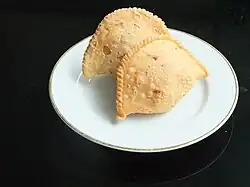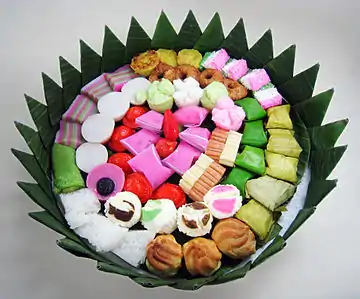Kue pastel
In Indonesia, pastel refers to a type of kue filled with meat, vegetables, and rice vermicelli deep fried in vegetable oil. It is consumed as a snack and commonly sold in Indonesian traditional markets.[1] The similar Manadonese version replaces the thin crust with bread filled with spicy cakalang (skipjack tuna) and is called panada.
 Indonesian pastel | |
| Type | Kue |
|---|---|
| Course | Snack |
| Place of origin | Indonesia |
| Serving temperature | Hot or room temperature |
Pastels are derived from the Portuguese influence in Indonesia. It is a type of kue made of thin pastry crust, with a filling of meat (usually chicken or beef), vegetables (carrots and bean sprouts), rice vermicelli, and sometimes boiled eggs, then deep fried in vegetable oil. It is consumed as a snack and is commonly sold in Indonesian traditional markets.[1] The snack is very popular during iftar for Ramadan.[1]
The similar North Sulawesi version replaces the thin flour pie crust with bread, and is filled with spicy cakalang (skipjack tuna). This variation of the snack is called panada.[2]
The similar Riau Islands version of pastel is called epok-epok.
See also
References
- "Benhil Market, "Takjil" Heaven". Tempo.co. 13 July 2013.
- "Panada Recipe (Manado Tuna Stuffed Bread/Pastry)". Indonesia Eats. 4 September 2010.
